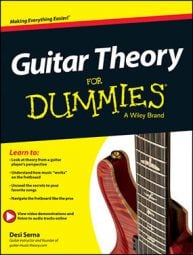Like the C form, the G form barre chord is hard to play on the guitar and rarely, if ever, used in its entirety. Don’t worry about being able to play it perfectly because more often than not, you break it down into other, more manageable shapes. You use the G form to form major chords for notes along the 6th string.
![[Credit: Illustration courtesy of Desi Serna]](https://www.dummies.com/wp-content/uploads/416458.image0.jpg)
Play the full G form arpeggio pattern shown here. It includes an additional note on the 2nd string. Play it as a scale.The additional chord tone on the 2nd string explains why you can play an open G chord with either the 2nd string open, B, or the 3rd fret of the 2nd string, D. Both notes are part of the chord.
![[Credit: Illustration courtesy of Desi Serna]](https://www.dummies.com/wp-content/uploads/416459.image1.jpg)
Here is how to play G form chord voicings.
![[Credit: Illustration courtesy of Desi Serna]](https://www.dummies.com/wp-content/uploads/416460.image2.jpg)
A features a part of the barre chord that’s used in the song “Snow (Hey Oh)” by Red Hot Chili Peppers as a B.
B shows the C/G used in the opening to “Stairway to Heaven” by Led Zeppelin.
C shows the F/A used in the opening to “The Wind Cries Mary” by Jimi Hendrix.
D is a very common, open position G/B. Variations of this shape are used in many acoustic guitar songs, such as “Dust in the Wind” by Kansas, “Landslide” by Fleetwood Mac, and “Blackbird” by The Beatles.
Other songs that make use of G form chord voicings include
“China Grove” by The Doobie Brothers
“Fade to Black” by Metallica
“Gimme Three Steps” by Lynyrd Skynyrd
“Tears in Heaven” by Eric Clapton
The G form has three notes in a row on strings 2–4 just like the A form. In fact, the two forms are connected by this group of notes. Now you see that this type of chord change can be viewed as a combination of the G form and C form too.

